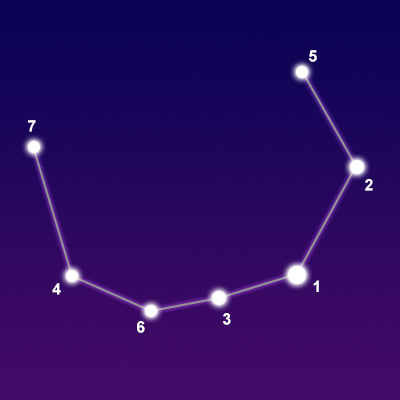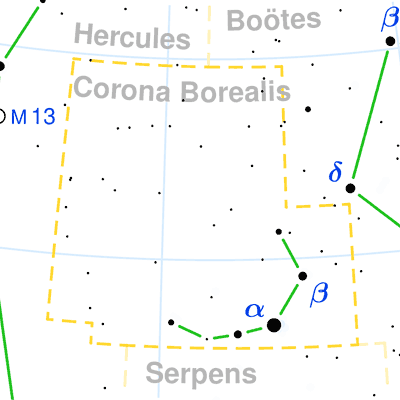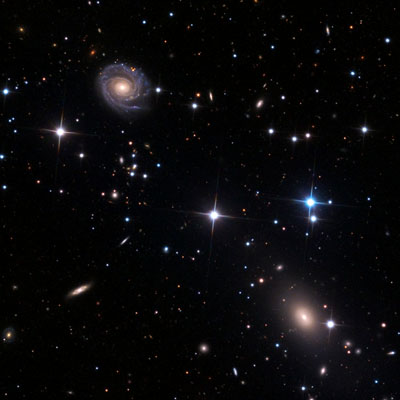Pronunciation:
(koh-ROH-nuh BOR-ee-AL-is)Abbreviation:
CrBGenitive:
Coronae BorealisRight Ascension:
16 hoursDeclination:
30 degreesArea in Square Degrees:
179Crosses Meridian:
9 PM, June 30Visible Between Latitudes:
90 and -50 degreesThe constellation Corona Borealis, the northern crown, is visible in the northern hemisphere in the spring and summer. It can be seen at latitudes between 90 degrees and -50 degrees. It is a small constellation covering 179 square degrees of the sky. It ranks 73rd in size among the 88 constellations in the night sky. It is bordered by Boötes to the north and west, Serpens Caput to the south, and Hercules to the east.
Corona Borealis is one of the 48 constellations listed by the Greek astronomer Ptolemy in the second century. Its name means “northern crown” in Latin. This is an ancient constellation that has its roots in many cultures. It has been depicted as a circle of elders, an eagle’s nest, and a bear’s den. In Celtic mythology, it was known as Caer Arianrhod, the Castle of Arianrhod. It represented the home of the Lady Arianrhod. In Greek mythology, it represented the crown that Ariadne, the daughter of King Minos of Crete, wore at her wedding. Her ball of thread helped Theseus defeat the Minotaur and find his way out of the labyrinth. Theseus gave her the crown when they married. The crown was created by the supreme goldsmith of the gods, Hephaestus.

points of interest below © Sea and Sky

© Torsten Bronger CC BY-SA 3.0
Nusakan
Gamma Coronae Borealis
Epsilon Coronae Borealis
Theta Coronae Borealis
Delta Coronae Borealis
Iota Coronae Borealis
"The Two Series"
N/A
N/A
N/A
N/A
N/A
Binary Star System
Binary Star System
Multiple Star System
Binary Star System
Yellow Giant Star
Binary Star System
3.68
3.84
4.13
4.13
4.63
4.98
Corona Borealis is a relatively dim constellation with only three stars brighter than magnitude 3. The brightest is Alphecca, with a visual magnitude of 2.23. It is a binary star system located approximately 75 light years from Earth. The second brightest star is Nusakan with a magnitude of only 3.68. It is also a binary star system. Nusakan lies 114 light years from our solar system. Gamma Coronae Borealis is the third brightest star with a magnitude of only 3.84. It, too, is a binary star system. The two stars orbit each other every 93 years and are about as far apart as our Sun and the planet Neptune.
Corona Borealis contains no Messier objects but does contain a few notable deep-sky objects that can only be seen in large telescopes. The Corona Borealis Galaxy Cluster is a dense cluster of about 400 galaxies that spans an area of about one degree of the sky. This constellation is also the home of the Blaze Star, also known as T Coronae Borealis. It is a recurring nova that normally has a visual magnitude of about 10. During its outbursts, it can brighten to a magnitude of as high as 2.

Lemmon SkyCenter/University of Arizona / CC BY 3.0



